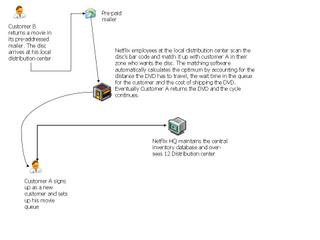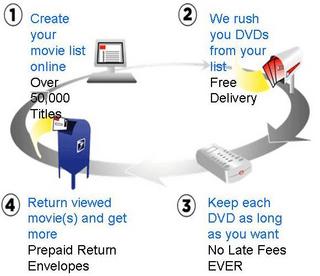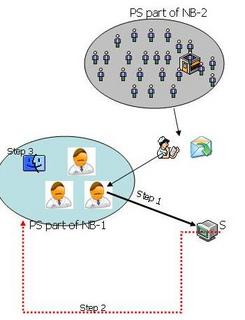"New" Netflix in India
Sounds familiar ???
Netflix meets eBay ???
As Amit Varma pointed out in an email conversation, "If it's restricted to a city, then some DVD outlets in Mumbai already hand-deliver DVDs' anywhere in the city and pick it up". The need is then for a system which is low-cost and at the same time offers a wide variety of choice in an integrated fashion throughtout the area of coverage. That is when I thought of a Netflix meets eBay system. The system offers a "virtual auction" where you would be able to search for a particular media or a genre of media, make selections and either pick it up or have it delivered.
Roomie 1. Arrgh, nothing to do on a Sunday afternoon
Roomie 2. Let us head to the Neighborhood Store (NB) to see if they have something new
Roomie 1. Naah, he has nothing new to offer.......
In an age where everything is delivered direct to doorsteps,it is not surprising that a subscription service for Media would follow. Traditional video rental (both in India and United States), involves stores, manned by store employees and carry a certain number of titles. You pick up the an available title from a selection, pay the price and return it in the allocated time, else you are subjected to late return fine. A proof of identity is usually required, either through a Credit Card (CC) orHome Address (HA).
Brief Description of how Netflix works
In the case of Netflix, for $19.95 per month, a member can get up to three titles at a time sent to his house through first class postal service, up to eight for a higher subscription rate. There are no late fees and no due dates. Members fill out a rental queue in their online profile and Netflix sends them the first three selections immediately. Netflix deals exclusively in only DVDs. Additionally, customers get a prepaid envelope with their DVD selections which they can put their DVD slips and ship it back to Netflix. While Blockbuster owns its DVDs' outright, Netflix has established contracts with most most studioswherein Netflix agrees to kickback a percentage of subscription fees for every movie r
postal service, up to eight for a higher subscription rate. There are no late fees and no due dates. Members fill out a rental queue in their online profile and Netflix sends them the first three selections immediately. Netflix deals exclusively in only DVDs. Additionally, customers get a prepaid envelope with their DVD selections which they can put their DVD slips and ship it back to Netflix. While Blockbuster owns its DVDs' outright, Netflix has established contracts with most most studioswherein Netflix agrees to kickback a percentage of subscription fees for every movie r ented in exchange for the opportunity to purchase DVDs' at a cost. The lower purchase costs allow Netflix to purchase a deeper copy depth on a title and better meet demand for a title without the substantial capital investment of full ownership.
ented in exchange for the opportunity to purchase DVDs' at a cost. The lower purchase costs allow Netflix to purchase a deeper copy depth on a title and better meet demand for a title without the substantial capital investment of full ownership.
In the case of Netflix, for $19.95 per month, a member can get up to three titles at a time sent to his house through first class
 postal service, up to eight for a higher subscription rate. There are no late fees and no due dates. Members fill out a rental queue in their online profile and Netflix sends them the first three selections immediately. Netflix deals exclusively in only DVDs. Additionally, customers get a prepaid envelope with their DVD selections which they can put their DVD slips and ship it back to Netflix. While Blockbuster owns its DVDs' outright, Netflix has established contracts with most most studioswherein Netflix agrees to kickback a percentage of subscription fees for every movie r
postal service, up to eight for a higher subscription rate. There are no late fees and no due dates. Members fill out a rental queue in their online profile and Netflix sends them the first three selections immediately. Netflix deals exclusively in only DVDs. Additionally, customers get a prepaid envelope with their DVD selections which they can put their DVD slips and ship it back to Netflix. While Blockbuster owns its DVDs' outright, Netflix has established contracts with most most studioswherein Netflix agrees to kickback a percentage of subscription fees for every movie r ented in exchange for the opportunity to purchase DVDs' at a cost. The lower purchase costs allow Netflix to purchase a deeper copy depth on a title and better meet demand for a title without the substantial capital investment of full ownership.
ented in exchange for the opportunity to purchase DVDs' at a cost. The lower purchase costs allow Netflix to purchase a deeper copy depth on a title and better meet demand for a title without the substantial capital investment of full ownership.
Netflix has 12 distribution centers spread all across continental United States, so the average wait time for a DVD is around 1 or 2 days. The above images illustrates the way Netflix functions. With their current setup, Netflix fills approximately 98% of customer orders. The system automatically determines the amount of inventory which has been consistently unused and it is shipped back to the company headquarters in San Jose. Evidently, Netflix is a very popular website. The company's subscriber base has doubled year after year since launch in 1998. What has proven advantageous for Netflix are the some key factors,
- DVD players and media prices have rapidly dropped making them a mainstream electronics item.
- Movie studios have quickly realized that the DVD is a lucrative distribution medium. Movies can have a longer life because of DVD rentals and some movies do exceedingly well on the DVD circuit.
- An opportunity to take the convenience of renting movies to the next level using the Internet as a medium. Additionally, the system allows both frequent rentals and not so frequent rentals.
- No late fees. Additionally, there is very little to no chance that one of the distribution centers will not have the movie of your choice.
- Complete outsourcing of distribution to USPS while retaining warehouse and inventory management.
- Dynamic partnership with Best Buy allows users to use Netflix kiosks in Best Buy stores to rent movies. In return, Netflix directs users to buy DVDs'from the Best Buy website.
The challenge is can a Netflix type system exist in India ? For any type of DVD subscription service, there has to be an unprecedented rate of hardware price decrease, an unprecedented rate of content support and a huge public base . All these conditions exist in India. Let us start with the obvious advantages and disadvantages first before I can explore a new concept.
- it is easy for a company to strike deals with all of them,
- Increasing buying power and penetration of DVD players in the market. Still, there is a tremendous market waiting to be discovered in terms of content penetration,
- Viewership retention (% of people who would want to watch a movie repeatedly) is much higher in India as compared to other countries.
Old and antiquated postal system means the necessity of using a courier systemdrive the distribution costs to extremely high levels, rendering the system unusable to a majority of the target audience. One more problem is that a traditional distribution system solely dependent on the Indian postal system would not work because there are several small towns where there is extremelyerratic supply of regular post, leave aside media.Media companies have to be demonstrated proof of copyright protection and a big share of the revenue would have to be shared with the companies.
The obvious fix to such a system would be to have a Netflix type restricted to just the metro areas - Mumbai, Bangalore, etc. with stand-alone distribution centers. You would then use a local courier system and have each distribution center also specialize in local movies. Example, the Mumbai DC could also stock Gujarati and Marathi movies apart from the Hindi movies. The DCs' in the South would have a lesser inventory of Hindi movies and concentrate on the vernacular movie industry. The main drawbacks of this system are still the high costs (costs of operating the system, the backbone of DCs' and the courier system).
Netflix meets eBay ???
As Amit Varma pointed out in an email conversation, "If it's restricted to a city, then some DVD outlets in Mumbai already hand-deliver DVDs' anywhere in the city and pick it up". The need is then for a system which is low-cost and at the same time offers a wide variety of choice in an integrated fashion throughtout the area of coverage. That is when I thought of a Netflix meets eBay system. The system offers a "virtual auction" where you would be able to search for a particular media or a genre of media, make selections and either pick it up or have it delivered.
How the system works

Key notations
1. Neighborhood uncle (NB)
2. Consumers, referred to as PS or Poor Souls
3. System ("S")
Key assumptions
1. NBs' would willingly join the system and abide by its rules (Big hope)
System Steps
Step 1. All the NBs' are in the system. The media is either owned by S (is bar-coded and kept at NB sites, aka Vendor Managed Inventory).
Step 2. As a system participant, PS has to fulfill two requirements, a. He has to be a part of a group (or more than one group). The group moderator is NB. b. There has to be some proof of identity, either through a Credit card on record in S or proof of home address (verified by NB)
Step 3. Each PS is ranked by NB and this ranking is incorporated in the S against the PS profile. This ranking can range from "newbie" for a new customer to an "junkie" for a die-hard media fan
Step 4. PS-1, a part of NB-1 searches for a particular media format, say Aman aur Jung, a documentary movie not available with his NB-1. S returns back with a result that a copy of the documentary in DVD format is available with PS-2 who is a part of NB-2. The price of the rental and the period of rental are also indicated in the query result. PS-1 has five choices,
a. Accept the transaction and take delivery of the media format at the NB-2 location,
b. Accept the transaction and take courier delivery
c. Accept the transaction and take postal delivery. Postal delivery is only available through registered mail, so PS-1 assumes this cost
d. Accept the transaction and take delivery of the media at NB-1
e. Decline the transaction
Step 4a (Simultaneous steps). NB-2 has a chance to stop this transaction if the rating of PS-1 is not within acceptable levels Step 4b. Depending on the PS-1 choice, NB-2 schedules the delivery. Step 4c. In case of a successful transaction (PS-1 taking delivery and returning the media in perfect condition), NB-1 puts a good rating against PS-1 and NB-2 does likewise for PS-2. This system is the same if the media is owned/placed at NB-2. Just like eBay, you get a feedback score and NBs' or other PSs' can choose to do business with you on your feedback score
How does S make money
S makes money anytime S hosted media is rented out. S also charges a per transaction cost. Additionally, S can provide additional services (like a CineMatch software which can record your previous buying preferences and make future recommendations).
How do NBs' make money
NBs' can make more money because their range has now increased beyond their immediate geographical area. How do PSs' benefit. PSs' can gain a far better media library to choose from. Additionally, they would make money if one of their media items gets rented.
How do the PS benefit - An extra avenue of earning money for media lying otherwise dormant. Additionally, a wide range of media to choose from.
There are obvious questions (and logical answers) for such a system. But it is extremely doable and given the right backing of media companies and NBs', is a sure bet to success.
A big thanks to Amit Varma, Aggie, Confusion Personified and M for their ideas for this post.

Key notations
1. Neighborhood uncle (NB)
2. Consumers, referred to as PS or Poor Souls
3. System ("S")
Key assumptions
1. NBs' would willingly join the system and abide by its rules (Big hope)
System Steps
Step 1. All the NBs' are in the system. The media is either owned by S (is bar-coded and kept at NB sites, aka Vendor Managed Inventory).
Step 2. As a system participant, PS has to fulfill two requirements, a. He has to be a part of a group (or more than one group). The group moderator is NB. b. There has to be some proof of identity, either through a Credit card on record in S or proof of home address (verified by NB)
Step 3. Each PS is ranked by NB and this ranking is incorporated in the S against the PS profile. This ranking can range from "newbie" for a new customer to an "junkie" for a die-hard media fan
Step 4. PS-1, a part of NB-1 searches for a particular media format, say Aman aur Jung, a documentary movie not available with his NB-1. S returns back with a result that a copy of the documentary in DVD format is available with PS-2 who is a part of NB-2. The price of the rental and the period of rental are also indicated in the query result. PS-1 has five choices,
a. Accept the transaction and take delivery of the media format at the NB-2 location,
b. Accept the transaction and take courier delivery
c. Accept the transaction and take postal delivery. Postal delivery is only available through registered mail, so PS-1 assumes this cost
d. Accept the transaction and take delivery of the media at NB-1
e. Decline the transaction
Step 4a (Simultaneous steps). NB-2 has a chance to stop this transaction if the rating of PS-1 is not within acceptable levels Step 4b. Depending on the PS-1 choice, NB-2 schedules the delivery. Step 4c. In case of a successful transaction (PS-1 taking delivery and returning the media in perfect condition), NB-1 puts a good rating against PS-1 and NB-2 does likewise for PS-2. This system is the same if the media is owned/placed at NB-2. Just like eBay, you get a feedback score and NBs' or other PSs' can choose to do business with you on your feedback score
How does S make money
S makes money anytime S hosted media is rented out. S also charges a per transaction cost. Additionally, S can provide additional services (like a CineMatch software which can record your previous buying preferences and make future recommendations).
How do NBs' make money
NBs' can make more money because their range has now increased beyond their immediate geographical area. How do PSs' benefit. PSs' can gain a far better media library to choose from. Additionally, they would make money if one of their media items gets rented.
How do the PS benefit - An extra avenue of earning money for media lying otherwise dormant. Additionally, a wide range of media to choose from.
There are obvious questions (and logical answers) for such a system. But it is extremely doable and given the right backing of media companies and NBs', is a sure bet to success.
A big thanks to Amit Varma, Aggie, Confusion Personified and M for their ideas for this post.
Comments